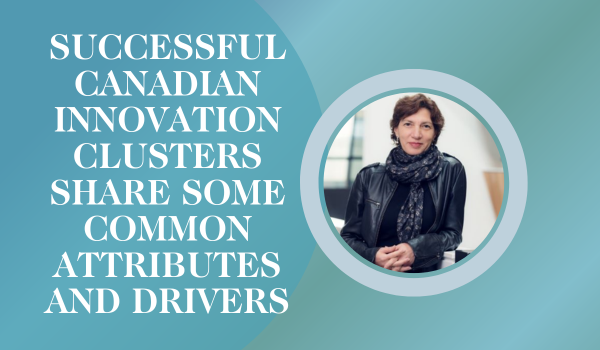Innovation ecosystem lacks sound architecture, workforce strategy and science-savvy policy makers
Canada’s innovation ecosystem lacks an effective science and technology architecture and a workforce innovation strategy, with a gap between science and policy, panelists told Research Money’s 23rd annual conference.
The ecosystem is not underpinned by an industrial strategy, existing workers and the new workforce aren’t upskilled for innovation, and there’s scarce understanding of science among policy-makers, panelists told a session on “Diagnosing the sand in the gears.”
 “We have some ingredients [required for innovation], but we don’t have the science and technology architecture of an innovative country,” said Robert Asselin (photo at right), senior vice-president, policy, at the Business Council of Canada.
“We have some ingredients [required for innovation], but we don’t have the science and technology architecture of an innovative country,” said Robert Asselin (photo at right), senior vice-president, policy, at the Business Council of Canada.
“Overall, what I’m not seeing is an ecosystem that works toward a clear industrial policy for innovation,” he said.
Innovation programs are disconnected from one another and there’s no organization in Canada like DARPA (the Defense Advanced Research Projects Agency) in the U.S. to galvanize industrial research with the private sector, Asselin said. “It [innovation] is not being done in an intentional way in advanced industries where we need it.”
The National Research Council, for example, “is a legacy institution,” he said. “It’s not one that will bring us that kind of element [innovating in advanced industries] in the ecosystem.”
Eighty-four per cent of Canada’s GDP is comprised of real estate, consumption and current government expenditure, Asselin noted. “That’s not sustainable if we want to be more productive and grow our economy going forward.”
 Rhonda Barnet, (photo at left), CEO at Palette Skills, said a strength of Canada’s innovation ecosystem is that the country now ranks second among OECD countries for the percentage of its citizens who have post-secondary education.
Rhonda Barnet, (photo at left), CEO at Palette Skills, said a strength of Canada’s innovation ecosystem is that the country now ranks second among OECD countries for the percentage of its citizens who have post-secondary education.
Despite this, “the biggest impediment to growth is around the availability of skilled talent,” she said.
It’s not enough to educate people and let them join the workforce for 30 or 40 years and think that that’s sufficient, that they’ve got the right set of skills to transition and be able to support innovative companies in the right way, Barnet said.
“The biggest sand in the gears is really around a workforce innovation strategy for Canada that really lets us compete globally on talent.”
Barnet, who has been an entrepreneur running a startup, said Canada needs to focus not only on post-secondary degrees but on lifelong learning and ensuring the country’s workforce is continuously retooled throughout people’s working lives.
Investments are needed to ensure Canada has a highly technical skilled workforce to meet the challenges of innovation in industry and academia, Barnet said.
 Another sand in the gears for Canada’s innovation ecosystem is the gap between science and policy, said Sarah Laframboise (photo at right), executive director at Evidence for Democracy.
Another sand in the gears for Canada’s innovation ecosystem is the gap between science and policy, said Sarah Laframboise (photo at right), executive director at Evidence for Democracy.
Most policy-makers have economic and policy backgrounds, not scientific backgrounds or STEM (science, technology, engineering, mathematics) training, she noted. And for scientists, it can be too comfortable to stay in the silo and not engage in the public policy process.
“So that’s a divide between these two large [sectors] that have to work together to solve any of these problems,” Laframboise said.
This divide also results in inadequate communication to the public about the importance of science and research, she added.
“If we want science and research to be funded, the public has to care and this has to be an election issue,” Laframboise said. “We don’t see that right now. The ‘care factor’ doesn’t really exist.”
Pick winners and support them, have a strategic long-range vision
The way Canada’s innovation system now works, government funds a bunch of programs and people submit projects for funding, Asselin said. “That’s a very passive way of doing innovation. Innovation has to be provoked.”
Canada has to start picking winners and targeting support on them, he said. “Countries that are successful have picked their winners and the winners are not companies, they’re sectors.”
Taiwan, for example, wouldn’t have become a global leader in semiconductors without having a deliberate industrial strategy for what they wanted to achieve, he said. Likewise, the Netherlands – a country half the size of New Brunswick – has become the world’s second-largest exporter of agricultural and ag-tech products.
But picking winners doesn’t mean providing enormous subsides to certain companies, Asselin said.
The federal, Ontario and Quebec governments have provided nearly $38 billion in subsidies and incentives to support electric vehicle battery manufacturing in Canada by Northvolt, Volkswagen and Stellantis-LGES, he noted.
“It’s really bad we’re doing that because we’re not doing any innovation at all,” he said. “We’re subsidizing jobs that already exist in the economy that we’ve moved essentially from SMEs to [foreign multinationals].”
From the macroeconomic and industrial policy perspectives, Canada would be further ahead to establish and support a corporate laboratory-incentivized system to design new technologies rather than simply assemble them, Asselin said.
Barnet agreed that with federal government investments, it is crucial to pick winners. But those winners, along with fledgling entrepreneurs and startups, need consistent and timely financial support, she said.
“We don’t have a lending system in Canada that supports the risk that entrepreneurs need to take to be innovating,” she added. “The banks aren’t going to give you the boost to believe in what you’re doing and make an investment.”
Session moderator Marie D’Iorio, president of Deep Tech Canada, pointed out that Canada’s innovation ecosystem not only needs to be more risk-taking, it needs to be founded on trust.
The country needs innovation support programs for early entrepreneurs that give them the opportunity to experiment and try things, without restrictions such as holding them to matching funding or creating a certain number of jobs within a set timeframe, D’Iorio said.
Barnet said multinationals will choose to do their R&D in whatever country offers the most attractive financial incentives.
For example, tech companies are flocking to the U.S. because of the generous subsidies offered by the Inflation Reduction Act and the Chips and Science Act.
“But if we really want to take advantage of these really innovative companies that we have in Canada, we have to find the right lending instruments to support them and the risk appetite they have for their company, to go and make these investments here in Canada,” Barnet said.
Canada needs a long-range, 50- to 100-year vision of where it’s going, she said, so the country can build the ecosystem it wants and make the right targeted investment in science, materials, infrastructure and other components.
Barnet and Asselin said Canada has four or five sectors that provide clear competitive advantages for Canada, such as in agriculture, biomanufacturing and energy and the energy transition.
“We need to have a long-term, clear vision of what we can achieve [as a country],” Barnet said. “And we have to be measuring all of the complex elements of that and all the interconnectivity of that.”
Infuse STEM skills learning throughout the education system
Part of that long-term vision should be instilling STEM skills and training in young Canadians at a very early age, including K to 12, the panelists said.
There’s still an imbalance in Canada’s post-secondary education system between the social sciences-humanities side and the STEM side, Asselin said. “We’re not doing that well on STEM.”
“Innovation comes from science and engineering, it comes from STEM,” he said. “Countries that are good at innovation are very good at STEM.”
Laframboise noted that it is from K to 12 when young people’s lives are shaped and they start making personal decisions about whether to go to college or university or grad school, or pursue a career, or do a post-doctoral fellowship internationally.
Research shows that many Canadian graduates are leaving the country now for more attractive jobs and higher salaries, she said. Those that stay are staying for family, universal health care and mental health reasons.
In developing the innovation talent pipeline, “we need to humanize the talent issues we’re seeing. It’s about personal decisions,” Laframboise said.
Barnet said that to develop the highly skilled workforce for innovation that Canada needs, the education system needs to think about putting industry in the driver’s seat more.
For example, when graduates come out of post-secondary institutions with a degree, what specific skills are they still missing that could translate into landing a high-demand job, she said. And how could these skills be built into post-secondary education programs?
The organization Barnet leads, Palette Skills, in February 2023 received a $250-million investment from Innovation, Science and Economic Development Canada’s ’s Upskilling for Industry Initiative, to support the development and implementation of short-cycle upskilling programs driven by industry needs in Canada’s highest-growth sectors.
Palette Skills’ program is industry-led, with industry identifying the specific skills they need, Barnet said. “We’re going to then upskill people with those specific skills in a targeted, quick way to make sure that they get straight into the next job.”
It’s also important for people in the current workforce and those pursuing careers to be role models for young people in encouraging them to recognize the importance of science and technology now and especially in the future, Barnet said.
“Lifelong learning, experiential learning is such a fundamental aspect of modern education,” she said.
Asselin said Canada can only benefit by instilling more STEM skills in young people, the workforce and policy-makers, and by having an industrial strategy focused on advanced industries that builds a bridge between ideas, intellectual capital and corporations.
“In the end,” Asselin said, “it is our innovation-driven economy that will give us more, that will give us abundance.”
R$
Events For Leaders in
Science, Tech, Innovation, and Policy
Discuss and learn from those in the know at our virtual and in-person events.
See Upcoming Events
You have 0 free articles remaining.
Don't miss out - start your free trial today.
Start your FREE trial Already a member? Log in
By using this website, you agree to our use of cookies. We use cookies to provide you with a great experience and to help our website run effectively in accordance with our Privacy Policy and Terms of Service.





